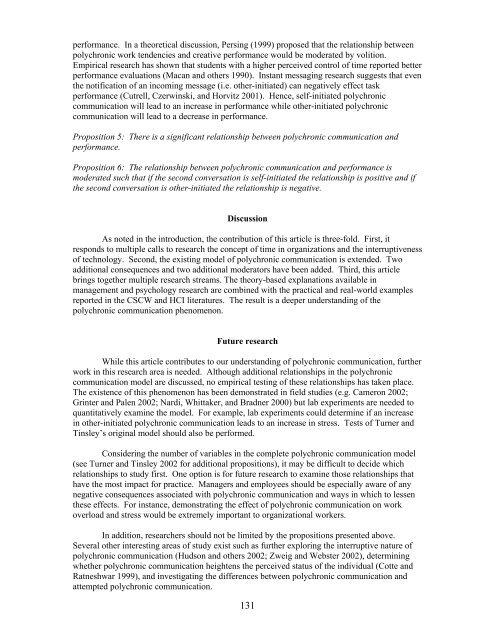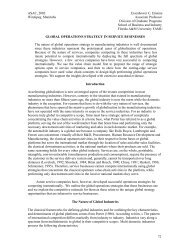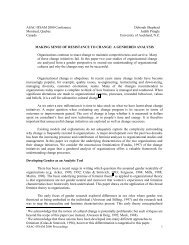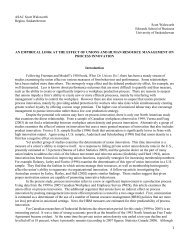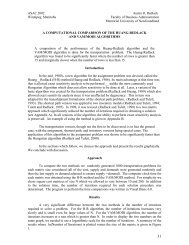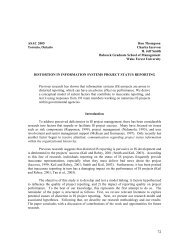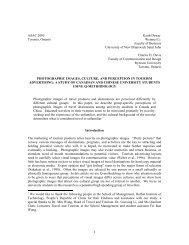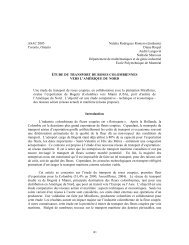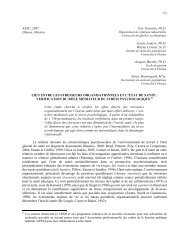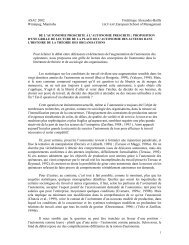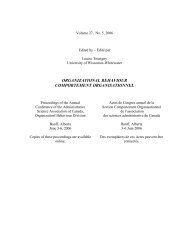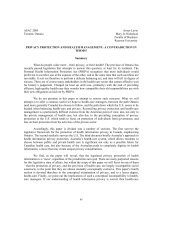Organizational Behaviour Comportement Organisationnel
Organizational Behaviour Comportement Organisationnel
Organizational Behaviour Comportement Organisationnel
Create successful ePaper yourself
Turn your PDF publications into a flip-book with our unique Google optimized e-Paper software.
performance. In a theoretical discussion, Persing (1999) proposed that the relationship betweenpolychronic work tendencies and creative performance would be moderated by volition.Empirical research has shown that students with a higher perceived control of time reported betterperformance evaluations (Macan and others 1990). Instant messaging research suggests that eventhe notification of an incoming message (i.e. other-initiated) can negatively effect taskperformance (Cutrell, Czerwinski, and Horvitz 2001). Hence, self-initiated polychroniccommunication will lead to an increase in performance while other-initiated polychroniccommunication will lead to a decrease in performance.Proposition 5: There is a significant relationship between polychronic communication andperformance.Proposition 6: The relationship between polychronic communication and performance ismoderated such that if the second conversation is self-initiated the relationship is positive and ifthe second conversation is other-initiated the relationship is negative.DiscussionAs noted in the introduction, the contribution of this article is three-fold. First, itresponds to multiple calls to research the concept of time in organizations and the interruptivenessof technology. Second, the existing model of polychronic communication is extended. Twoadditional consequences and two additional moderators have been added. Third, this articlebrings together multiple research streams. The theory-based explanations available inmanagement and psychology research are combined with the practical and real-world examplesreported in the CSCW and HCI literatures. The result is a deeper understanding of thepolychronic communication phenomenon.Future researchWhile this article contributes to our understanding of polychronic communication, furtherwork in this research area is needed. Although additional relationships in the polychroniccommunication model are discussed, no empirical testing of these relationships has taken place.The existence of this phenomenon has been demonstrated in field studies (e.g. Cameron 2002;Grinter and Palen 2002; Nardi, Whittaker, and Bradner 2000) but lab experiments are needed toquantitatively examine the model. For example, lab experiments could determine if an increasein other-initiated polychronic communication leads to an increase in stress. Tests of Turner andTinsley’s original model should also be performed.Considering the number of variables in the complete polychronic communication model(see Turner and Tinsley 2002 for additional propositions), it may be difficult to decide whichrelationships to study first. One option is for future research to examine those relationships thathave the most impact for practice. Managers and employees should be especially aware of anynegative consequences associated with polychronic communication and ways in which to lessenthese effects. For instance, demonstrating the effect of polychronic communication on workoverload and stress would be extremely important to organizational workers.In addition, researchers should not be limited by the propositions presented above.Several other interesting areas of study exist such as further exploring the interruptive nature ofpolychronic communication (Hudson and others 2002; Zweig and Webster 2002), determiningwhether polychronic communication heightens the perceived status of the individual (Cotte andRatneshwar 1999), and investigating the differences between polychronic communication andattempted polychronic communication.131


